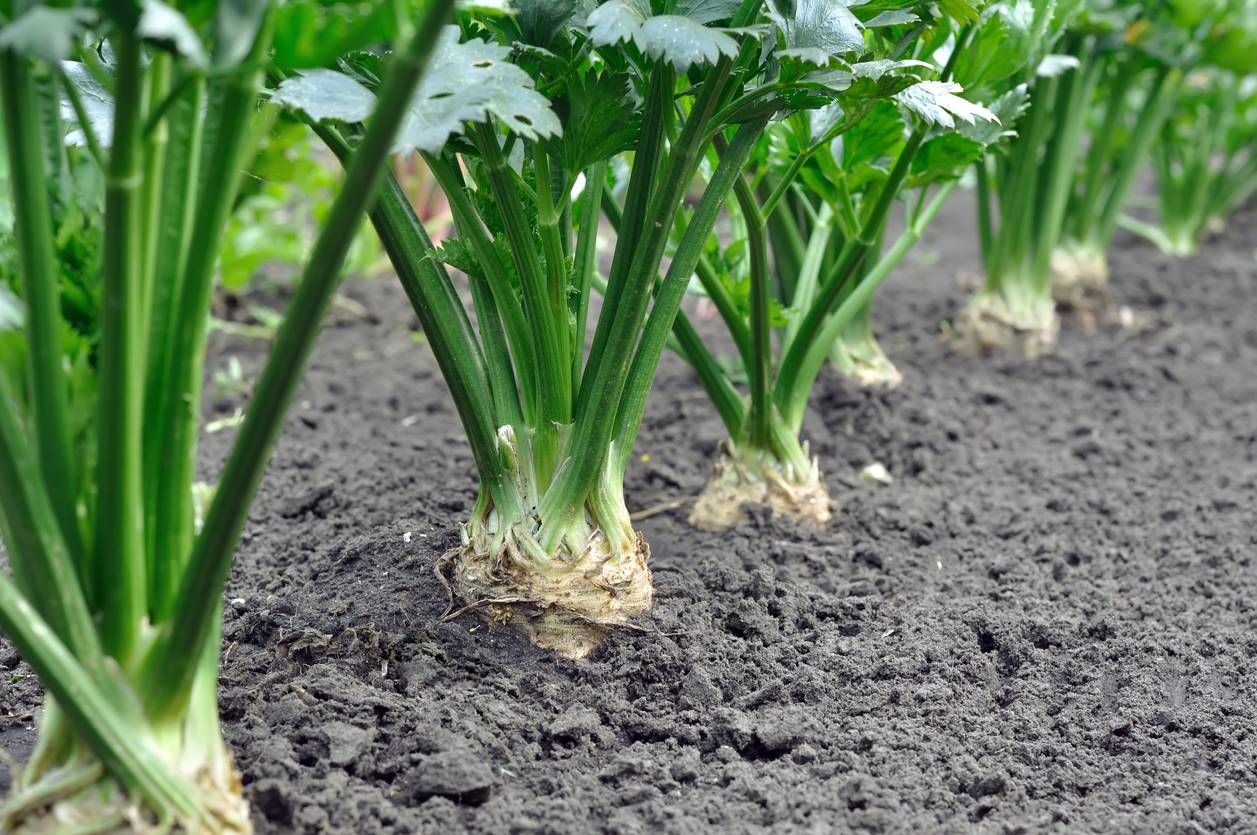But that changed a few years ago when a friend gave me a batch of parsnip fries to cook on the stove.
Parsnips cut into thin strips and tossed in with a little coconut oil, olive oil, or ghee heated up in a skillet. Salt and pepper to taste. Wow!.
We link to vendors to help you find relevant products. If you buy from one of our links, we may earn a commission.
A root crop similar to carrots, they offer a unique flavor that’s rich and slightly sweet. And they’re just the thing to turn common meals like soups and stews into something special.
You can also add them to a roasted root vegetable medley or eat them by themselves. These are especially good when sliced and served as fries. So. Good. So, so good.
Now, let’s talk about how to grow them. Here’s a quick rundown of what’s to come:
Do some research, keep at it, and be patient, and you should be able to grow this unique root vegetable in your own garden at home.
Unfortunately, I don’t lump parsnips in the “easy to grow” category. There’s a sort of finesse to getting their seeds to germinate.
But if you work on your plants at the start of the season, you can relax and watch them grow!
From the start, seeds are no longer viable after only one or two years, so it’s pretty common for them to have low germination rates. Because of this, you’ll want to order new seeds from a reputable source every year.
These are recommended by the Utah State University Extension because they do well in Utah (USDA Hardiness Zones 4–8) and are ready to harvest in about 100 days.
Though you can let parsnips flower and collect their seeds, keep in mind that they are biennials, which means you’ll have to leave them in the ground longer because they don’t flower until their second year. This can be an issue if growing space is already limited.
A lot of seed packets say to plant seeds as soon as the soil is workable, but it’s better to wait until the soil warms up to about 50°F, which usually happens in April.
You can use a soil thermometer to make sure you don’t plant too early, but two to three weeks after the spring solstice should be enough time. Any earlier, and seeds may rot before they have a chance to germinate.
Take a chance and plant seeds as soon as possible in the early part of the season. A few weeks later, plant another batch of seeds anyway. It can take up to a month for them to sprout, so planting more will give you a better chance of sprouting.
Choose a sunny spot and sow seeds directly in the garden about 1/2 inch apart. When they germinate and start to put on new growth, thin them to at least 6 inches apart.
Slow to get started, it’s common to plant another fast-maturing crop, like radishes, in between parsnips. Radishes will help you keep track of your rows, and planting this crop with them will help you make better use of your garden space. Beets, carrots, and salsify are also often planted with them.
Remember that starting root crop seeds indoors isn’t usually a good idea because moving them can often cause the roots to be misshapen.
To that same point, make sure your garden soil is rich, deep, and loamy. The roots of a parsnip can get up to a foot long, or even longer depending on the cultivar. Roots that are in poor, rocky soil can also grow in the wrong shape.
Even though it’s not recommended to start seeds indoors, you can help parsnip seeds sprout faster by putting them between two damp, folded paper towels and sealing the container.
Keep them in a sunny window and check regularly for germination. Plant the seeds in the garden as soon as they start to grow sprouts. Make sure the soil stays moist but not wet.
Too much or too little water can be tricky, but seeds won’t grow if the soil is too dry. Too wet, however, and seeds will likely rot.
In areas with long, cold winters, getting a head start on germination is especially helpful. Because parsnips need almost the whole growing season to be ready, you only get one chance to grow them each year, just like with tomatoes and peppers.
Repeated harvests (like carrots are so great for) really aren’t possible. So be sure to sow viable seeds, and plant them at the appropriate time.
There are many types of cultivated parsnips, but the “Hollow Crown” and “Harris Model” are two that are particularly good:
The ‘Hollow Crown’ variety takes about 100-120 days to reach maturity, producing smooth 12 to 15-inch roots.
Parsnips are an underappreciated and underutilized root vegetable that have a sweet, nutty flavor While they may not be as popular as potatoes or carrots, they deserve a place in every home garden. But what does a parsnip plant actually look like?
In this complete guide, we’ll cover everything you need to know to identify parsnip plants, including:
- Origin and history
- Physical characteristics
- Leaves
- Flowers
- Roots
- Differences from lookalikes
- Ideal growing conditions
- Common pests and diseases
A Brief History of the Parsnip
Parsnips are native to Eurasia and have been cultivated since ancient times. They were especially popular in Europe during the Middle Ages when sugar was scarce. The parsnip’s sweet flavor made it a useful sweetener and source of calories
Parsnips were brought to North America in the 1600s and grown by early colonists But after the potato become more readily available in the 1800s, the parsnip lost popularity and became more of a novelty crop
These days, parsnips are staging a modest comeback thanks to the rising interest in heirloom vegetables. And home gardeners are rediscovering how tasty and versatile they can be.
What Do Parsnip Plants Look Like? Key Identifying Traits
Parsnips belong to the Apiaceae plant family along with carrots, celery, and parsley. They are biennials, meaning they take two years to complete their lifecycle. But they are usually grown as annuals for their first-year edible root.
Here are the key traits to look for when identifying parsnip plants:
Leaves
- The first year, parsnips produce a rosette of pinnate, mid-green leaves.
- Leaves grow up to 40 cm long and have toothed margins.
- Leaves are arranged in pairs along the length of the leaf stem. There can be several pairs of leaflets.
- Leaves have a pale gray-green color and may be hairy.
- Leaves have a pungent odor when crushed.
Flowers
- In the second year, if left to overwinter, parsnips produce a tall flowering stem up to 5 ft high.
- The stem has few leaves and is topped by a flat-topped cluster of small yellow flowers called an umbel.
- Flowers bloom from June to August.
- The umbel can be 10-20 cm wide and contain 20-100 small flowers.
Roots
- Parsnip roots are cream colored and shaped like a carrot, but with a more tapered end.
- Most modern cultivars have long, slender roots, but some older types have a shorter, thicker root.
- Roots can be up to 18 inches long and 3 inches wide at the crown.
- The flesh is creamy white or yellow with a slight greenish tinge.
How to Distinguish Parsnips from Lookalikes
Parsnips resemble several other common vegetables. Here’s how to tell them apart:
-
Carrots – Parsnip roots are lighter in color than most carrots. The leaves are also lighter green and have a strong smell when crushed.
-
Salsify – Also called oyster plant, salsify has purple flowers and narrower leaves than parsnips. The roots are also thinner.
-
Parsley root – This lesser known vegetable has solid roots rather than the hollow, biennial growth habit of parsnips. The foliage is also darker green.
-
Wild parsnip – A weedy cousin of the cultivated parsnip. The roots are thinner, the plant has a pale yellow flower, and the sap can cause rashes.
Ideal Growing Conditions for Parsnips
To get the best parsnip crop, provide these growing conditions:
-
Sunlight – Full sun is ideal, at least 6 hours per day. Parsnips tolerate light shade.
-
Soil – They prefer soil with a pH of 6.0-7.0. Sandy loam or silt loam soil is best to allow for long straight roots.
-
Temperature – Germination occurs at soil temperatures around 50°F.
-
Water – Keep soil consistently moist but not waterlogged. Irrigate slowly and deeply.
-
Fertilizer – Avoid high-nitrogen fertilizer which causes excessive top growth. Use compost instead.
Common Pests and Diseases
Some potential problems to watch for when growing parsnips:
-
Carrot rust fly larvae – Feed on roots causing damage. Cover crops with fabric row covers.
-
Aphids – Suck plant sap. Knock off with water spray or treat with insecticidal soap.
-
Canker – Fungal disease causes rotted crowns. Improve air circulation and avoid wounding roots.
-
Root rot – Various fungi cause roots to rot. Don’t overwater and improve drainage.
Ready to Add Parsnips to Your Garden?
Now that you know what to look for, why not try growing some parsnips yourself? The long growing season and picky germination can make them a challenge. But the sweet, nutty roots are worth it.
Be sure to select fresh seeds each year and sow them in prepared, loose soil later in spring once it warms up. Keep them consistently watered and weed-free.
What You Need to Know About Parsnip Burn
I’m thankful I can’t speak from experience on this, but it definitely is worth mentioning.
There have been a number of stories of people who, given the right circumstances, have ended up with burnt, blistering skin, due to harvesting common garden crops! And while it’s not crazy common, it’s helpful to be aware of so you can hopefully avoid it yourself.
Usually, the rash that burns and itches is caused by wild parsnip, which is a pretty common weed that grows next to the road. But garden parsnip, which is just a tamed form of wild parsnip, as well as carrots and celery (which are all related), have been said to do the same thing.
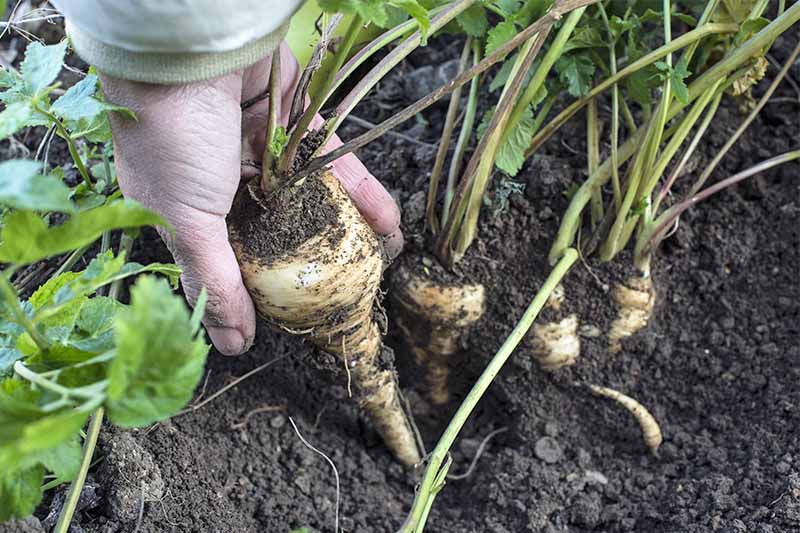
Moisture and sunshine seem to be the key factors for the reaction to occur.
Chemicals in the sap of leaves and stems first need to make contact with the skin. Water, like dew in the morning or a sweaty gardener, makes it easier for the chemicals to spread and be absorbed. And then the UV light from the hot sun comes in and triggers the reaction.
So, simply harvesting parsnips or carrots doesn’t mean you’ll have a reaction. It’s the combination of exposure, moisture, and sun that dooms you.
However, awareness is key, since the red, burnt, blistery skin usually doesn’t occur until days after exposure.
For your own safety, pick any crops you think might be infected early, before it gets too hot, and don’t pick them if they’re wet. And to go a step further, long sleeves, pants, and gloves will do the trick.
When the parsnips’ leaves start to fall off or when they reach a useful diameter of about 3/4 of an inch, they are ready to be picked.
Though, if you wait and harvest in the fall, after one or two hard frosts, the roots will be sweeter.
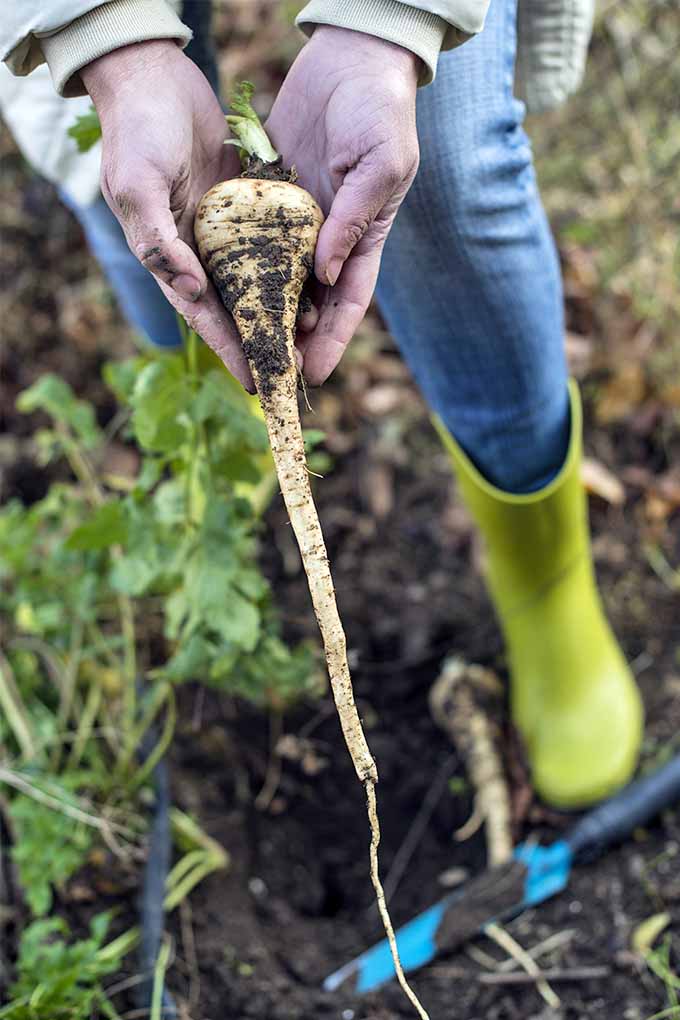
Even though they need a long growing season, parsnips are a great way to get homegrown food after most of the other vegetables have been eaten. And as long as the soil isn’t frozen, you can continue harvesting throughout the fall and into winter.
Plants can even be left to overwinter in the ground. Just put mulch around them and dig up the roots when the ground thaws in late winter or early spring.
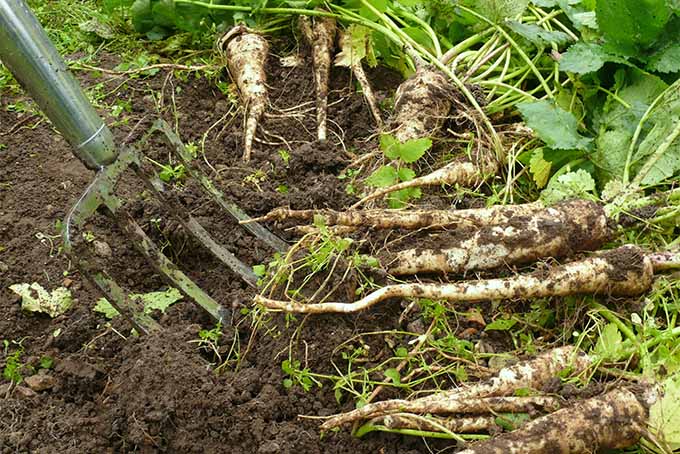
Pick the roots before they start to push new growth the next spring if you choose this method. Once new leaves begin to emerge, roots become more fibrous and tough.
As the roots are long and can easily break, take care to loosen the plants appropriately before harvesting.
Slow to Start, Strong to Finish
Don’t be too quick to relax once seeds germinate. After a few weeks, parsnips start to grow a lot, but weeds can beat them during that time.
Keep plants weed free during those first few weeks, and beyond that, you’re in the home stretch. As the leaves fill in and shade the surrounding soil, weeds become less of an issue.
Once plants start taking off, you can rest easy. Care for parsnips from this point on is very similar to that of growing carrots.
In general, adequate soil moisture throughout the summer is key to growing healthy root crops. It is especially important to water thoroughly during dry spells.
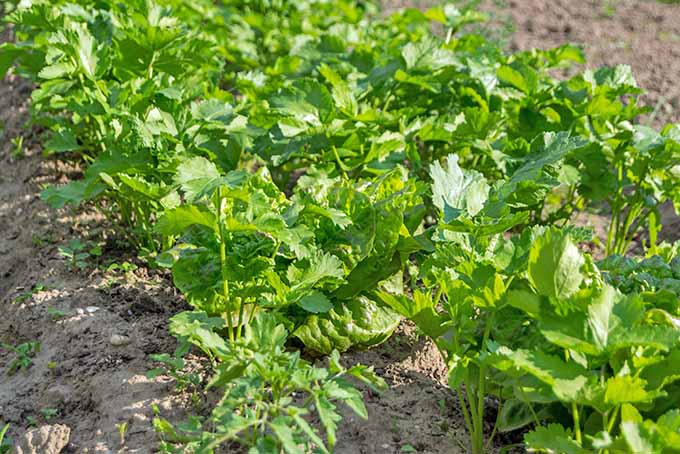
Roots go where there’s water. So, watering deeply encourages strong root growth. A good soaking is best achieved slowly, with soaker hoses or drip irrigation.
And if you tend to run the hose over your garden too quickly, setting up a simple irrigation system will help your garden, especially your root crops.
Frequent but shallow watering encourages shallow, weak roots, and plants that are even more susceptible to drought.
Ensure that the soil is well draining, since standing water can easily cause roots to rot.
There aren’t many pests or diseases that affect parsnips, but there are a few things you should watch out for as they grow:
Particularly those of swallowtail butterflies like to munch on the leaves.

Just pick them off if you see them.
These sap-sucking little insects can also pose an issue. My preferred method to control aphids is to simply blast them with the hose.
These flies – and more specifically their maggot larvae – feed on the roots of many root crops.
Prevention is best here. Try companion planting with chives, which are known to repel carrot flies.
Rotting of the root that starts at the top can result from drought or damage to the crown.
With all these things considered, you’re on your way to a successful harvest!
How to Grow Parsnips
FAQ
What other plant does wild parsnip look like?
Do parsnips come back every year?
What is the difference between a turnip and a parsnip?
How long does it take for parsnips to grow?
What does a parsnip look like?
Parsnips look like carrots but are usually cream-colored, and larger and fatter than their cousins. The foliage resembles celery foliage and forms a rosette shape at the top of the plant. Parsnips are a taproot and the vegetable portion is typically around 5-10” wide. If left to flower, they will produce yellow, umbel-shaped flowers.
Are parsnip seeds hard to grow?
Parsnip seeds are notoriously finicky and tough to germinate. Once they’ve sprouted and grown a bit, thin out the seedlings so that they’re no less than 3-inches apart with 24 inches between rows. Like carrots, parsnip doesn’t enjoy being transplanted.
Is parsnip a root vegetable?
How to Plant, Grow, and Harvest Parsnip Parsnip (Pastinaca sativa) is a root vegetable that belongs to the Apiaceae family and includes carrots, celery, parsley, and fennel.
Why do parsnips grow so long?
To that same point, make sure your garden soil is rich, deep, and loamy. Parsnip roots can grow to be up to a foot long (sometimes longer, depending on the cultivar) and poor, rocky soil can also cause misshapen roots.
- The Ultimate Guide to Growing Strawberries in Raised Beds - August 8, 2025
- No-Dig Garden Beds: The Easiest Way to Grow a Beautiful Garden - August 6, 2025
- How to Protect and Preserve Wood for Raised Garden Beds - August 6, 2025

